Ethical Dilemmas in Nursing Practice
VerifiedAdded on 2020/02/24
|10
|2551
|219
AI Summary
This assignment delves into the complexities of ethical dilemmas faced by nurses through a detailed case study. It analyzes the concept of duty of care, explores the potential legal repercussions of breaching ethical codes, and emphasizes the importance of upholding ethical principles in nursing practice. The student is tasked with applying these concepts to the presented scenario and proposing solutions that prioritize patient safety and well-being while adhering to professional standards.
Contribute Materials
Your contribution can guide someone’s learning journey. Share your
documents today.
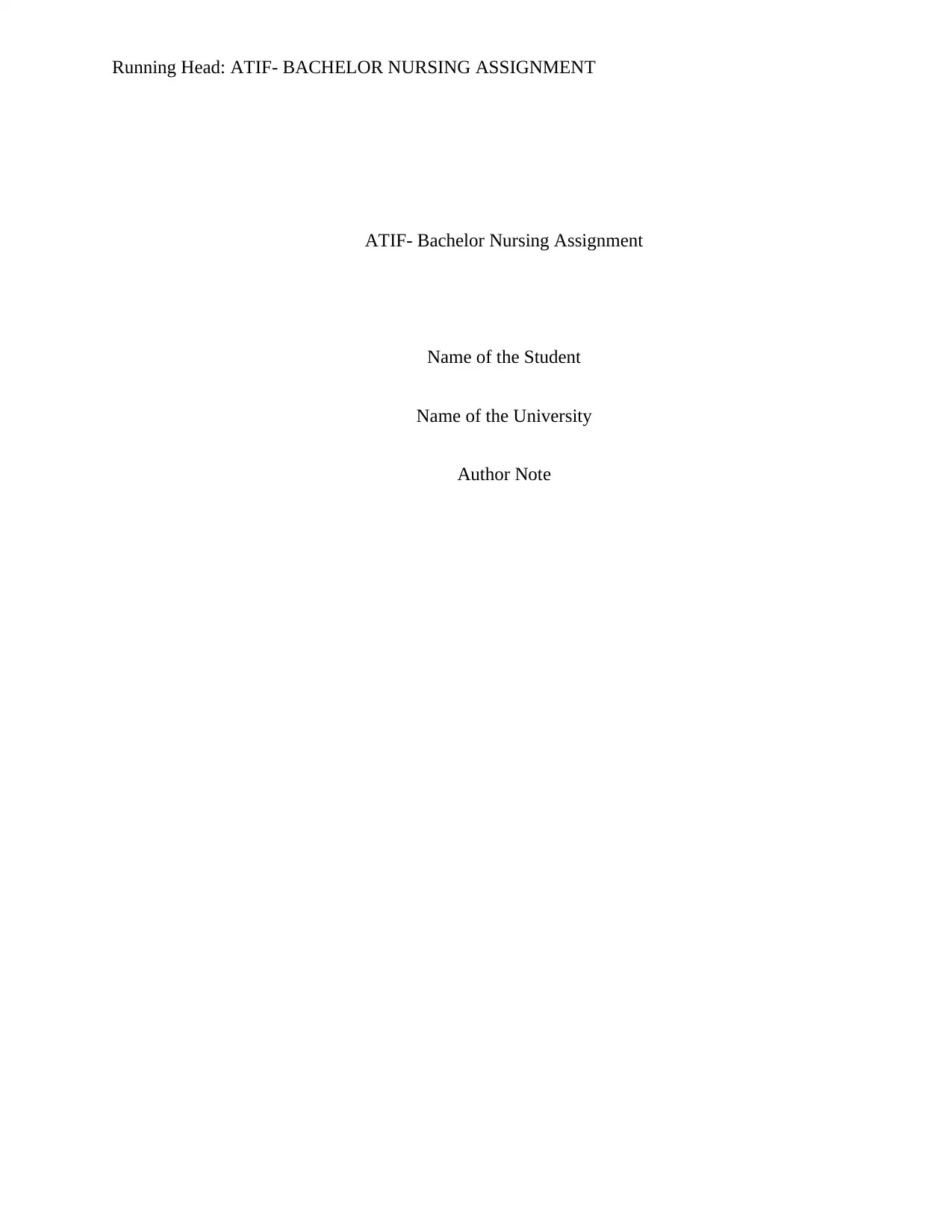
Running Head: ATIF- BACHELOR NURSING ASSIGNMENT
ATIF- Bachelor Nursing Assignment
Name of the Student
Name of the University
Author Note
ATIF- Bachelor Nursing Assignment
Name of the Student
Name of the University
Author Note
Secure Best Marks with AI Grader
Need help grading? Try our AI Grader for instant feedback on your assignments.
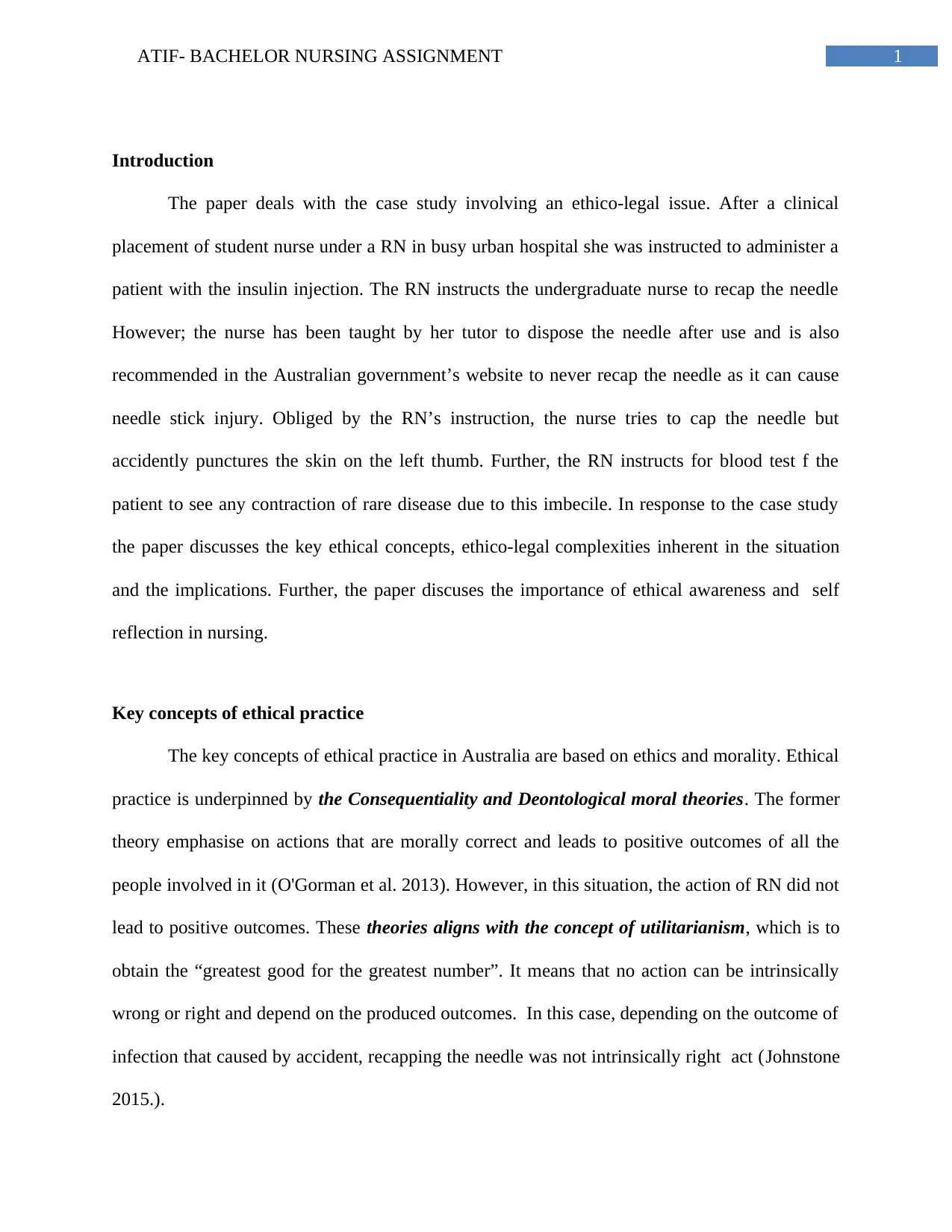
1ATIF- BACHELOR NURSING ASSIGNMENT
Introduction
The paper deals with the case study involving an ethico-legal issue. After a clinical
placement of student nurse under a RN in busy urban hospital she was instructed to administer a
patient with the insulin injection. The RN instructs the undergraduate nurse to recap the needle
However; the nurse has been taught by her tutor to dispose the needle after use and is also
recommended in the Australian government’s website to never recap the needle as it can cause
needle stick injury. Obliged by the RN’s instruction, the nurse tries to cap the needle but
accidently punctures the skin on the left thumb. Further, the RN instructs for blood test f the
patient to see any contraction of rare disease due to this imbecile. In response to the case study
the paper discusses the key ethical concepts, ethico-legal complexities inherent in the situation
and the implications. Further, the paper discuses the importance of ethical awareness and self
reflection in nursing.
Key concepts of ethical practice
The key concepts of ethical practice in Australia are based on ethics and morality. Ethical
practice is underpinned by the Consequentiality and Deontological moral theories. The former
theory emphasise on actions that are morally correct and leads to positive outcomes of all the
people involved in it (O'Gorman et al. 2013). However, in this situation, the action of RN did not
lead to positive outcomes. These theories aligns with the concept of utilitarianism, which is to
obtain the “greatest good for the greatest number”. It means that no action can be intrinsically
wrong or right and depend on the produced outcomes. In this case, depending on the outcome of
infection that caused by accident, recapping the needle was not intrinsically right act (Johnstone
2015.).
Introduction
The paper deals with the case study involving an ethico-legal issue. After a clinical
placement of student nurse under a RN in busy urban hospital she was instructed to administer a
patient with the insulin injection. The RN instructs the undergraduate nurse to recap the needle
However; the nurse has been taught by her tutor to dispose the needle after use and is also
recommended in the Australian government’s website to never recap the needle as it can cause
needle stick injury. Obliged by the RN’s instruction, the nurse tries to cap the needle but
accidently punctures the skin on the left thumb. Further, the RN instructs for blood test f the
patient to see any contraction of rare disease due to this imbecile. In response to the case study
the paper discusses the key ethical concepts, ethico-legal complexities inherent in the situation
and the implications. Further, the paper discuses the importance of ethical awareness and self
reflection in nursing.
Key concepts of ethical practice
The key concepts of ethical practice in Australia are based on ethics and morality. Ethical
practice is underpinned by the Consequentiality and Deontological moral theories. The former
theory emphasise on actions that are morally correct and leads to positive outcomes of all the
people involved in it (O'Gorman et al. 2013). However, in this situation, the action of RN did not
lead to positive outcomes. These theories aligns with the concept of utilitarianism, which is to
obtain the “greatest good for the greatest number”. It means that no action can be intrinsically
wrong or right and depend on the produced outcomes. In this case, depending on the outcome of
infection that caused by accident, recapping the needle was not intrinsically right act (Johnstone
2015.).
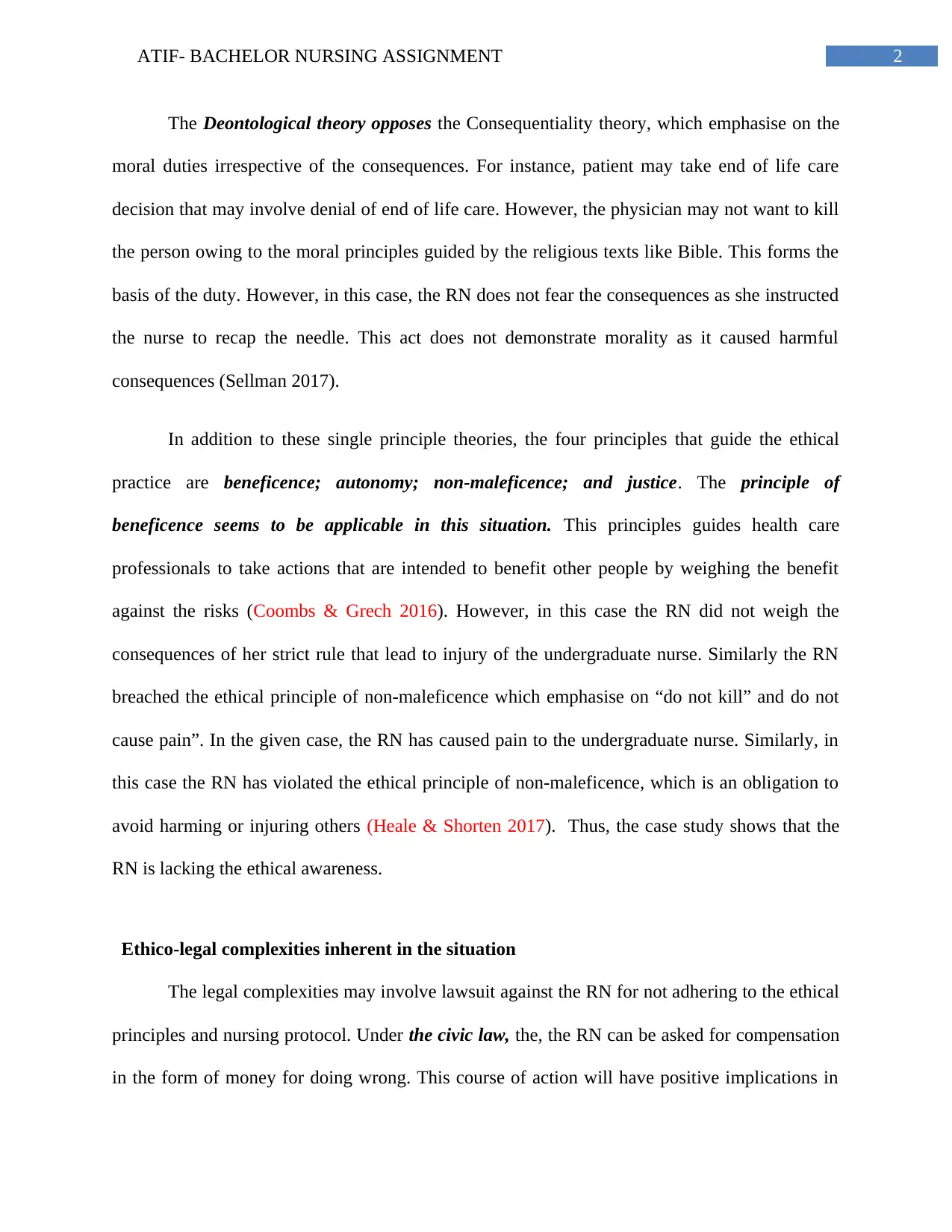
2ATIF- BACHELOR NURSING ASSIGNMENT
The Deontological theory opposes the Consequentiality theory, which emphasise on the
moral duties irrespective of the consequences. For instance, patient may take end of life care
decision that may involve denial of end of life care. However, the physician may not want to kill
the person owing to the moral principles guided by the religious texts like Bible. This forms the
basis of the duty. However, in this case, the RN does not fear the consequences as she instructed
the nurse to recap the needle. This act does not demonstrate morality as it caused harmful
consequences (Sellman 2017).
In addition to these single principle theories, the four principles that guide the ethical
practice are beneficence; autonomy; non-maleficence; and justice. The principle of
beneficence seems to be applicable in this situation. This principles guides health care
professionals to take actions that are intended to benefit other people by weighing the benefit
against the risks (Coombs & Grech 2016). However, in this case the RN did not weigh the
consequences of her strict rule that lead to injury of the undergraduate nurse. Similarly the RN
breached the ethical principle of non-maleficence which emphasise on “do not kill” and do not
cause pain”. In the given case, the RN has caused pain to the undergraduate nurse. Similarly, in
this case the RN has violated the ethical principle of non-maleficence, which is an obligation to
avoid harming or injuring others (Heale & Shorten 2017). Thus, the case study shows that the
RN is lacking the ethical awareness.
Ethico-legal complexities inherent in the situation
The legal complexities may involve lawsuit against the RN for not adhering to the ethical
principles and nursing protocol. Under the civic law, the, the RN can be asked for compensation
in the form of money for doing wrong. This course of action will have positive implications in
The Deontological theory opposes the Consequentiality theory, which emphasise on the
moral duties irrespective of the consequences. For instance, patient may take end of life care
decision that may involve denial of end of life care. However, the physician may not want to kill
the person owing to the moral principles guided by the religious texts like Bible. This forms the
basis of the duty. However, in this case, the RN does not fear the consequences as she instructed
the nurse to recap the needle. This act does not demonstrate morality as it caused harmful
consequences (Sellman 2017).
In addition to these single principle theories, the four principles that guide the ethical
practice are beneficence; autonomy; non-maleficence; and justice. The principle of
beneficence seems to be applicable in this situation. This principles guides health care
professionals to take actions that are intended to benefit other people by weighing the benefit
against the risks (Coombs & Grech 2016). However, in this case the RN did not weigh the
consequences of her strict rule that lead to injury of the undergraduate nurse. Similarly the RN
breached the ethical principle of non-maleficence which emphasise on “do not kill” and do not
cause pain”. In the given case, the RN has caused pain to the undergraduate nurse. Similarly, in
this case the RN has violated the ethical principle of non-maleficence, which is an obligation to
avoid harming or injuring others (Heale & Shorten 2017). Thus, the case study shows that the
RN is lacking the ethical awareness.
Ethico-legal complexities inherent in the situation
The legal complexities may involve lawsuit against the RN for not adhering to the ethical
principles and nursing protocol. Under the civic law, the, the RN can be asked for compensation
in the form of money for doing wrong. This course of action will have positive implications in
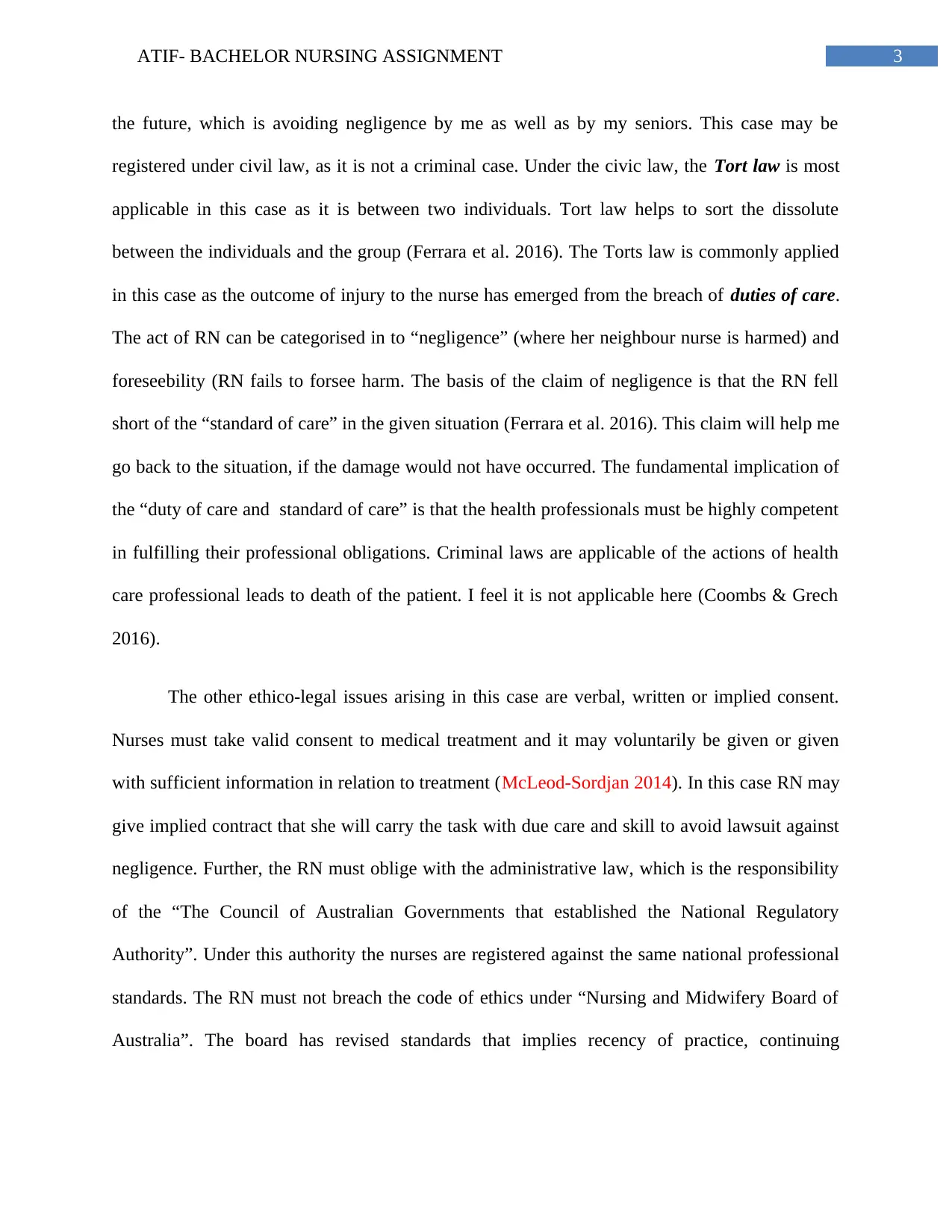
3ATIF- BACHELOR NURSING ASSIGNMENT
the future, which is avoiding negligence by me as well as by my seniors. This case may be
registered under civil law, as it is not a criminal case. Under the civic law, the Tort law is most
applicable in this case as it is between two individuals. Tort law helps to sort the dissolute
between the individuals and the group (Ferrara et al. 2016). The Torts law is commonly applied
in this case as the outcome of injury to the nurse has emerged from the breach of duties of care.
The act of RN can be categorised in to “negligence” (where her neighbour nurse is harmed) and
foreseebility (RN fails to forsee harm. The basis of the claim of negligence is that the RN fell
short of the “standard of care” in the given situation (Ferrara et al. 2016). This claim will help me
go back to the situation, if the damage would not have occurred. The fundamental implication of
the “duty of care and standard of care” is that the health professionals must be highly competent
in fulfilling their professional obligations. Criminal laws are applicable of the actions of health
care professional leads to death of the patient. I feel it is not applicable here (Coombs & Grech
2016).
The other ethico-legal issues arising in this case are verbal, written or implied consent.
Nurses must take valid consent to medical treatment and it may voluntarily be given or given
with sufficient information in relation to treatment (McLeod-Sordjan 2014). In this case RN may
give implied contract that she will carry the task with due care and skill to avoid lawsuit against
negligence. Further, the RN must oblige with the administrative law, which is the responsibility
of the “The Council of Australian Governments that established the National Regulatory
Authority”. Under this authority the nurses are registered against the same national professional
standards. The RN must not breach the code of ethics under “Nursing and Midwifery Board of
Australia”. The board has revised standards that implies recency of practice, continuing
the future, which is avoiding negligence by me as well as by my seniors. This case may be
registered under civil law, as it is not a criminal case. Under the civic law, the Tort law is most
applicable in this case as it is between two individuals. Tort law helps to sort the dissolute
between the individuals and the group (Ferrara et al. 2016). The Torts law is commonly applied
in this case as the outcome of injury to the nurse has emerged from the breach of duties of care.
The act of RN can be categorised in to “negligence” (where her neighbour nurse is harmed) and
foreseebility (RN fails to forsee harm. The basis of the claim of negligence is that the RN fell
short of the “standard of care” in the given situation (Ferrara et al. 2016). This claim will help me
go back to the situation, if the damage would not have occurred. The fundamental implication of
the “duty of care and standard of care” is that the health professionals must be highly competent
in fulfilling their professional obligations. Criminal laws are applicable of the actions of health
care professional leads to death of the patient. I feel it is not applicable here (Coombs & Grech
2016).
The other ethico-legal issues arising in this case are verbal, written or implied consent.
Nurses must take valid consent to medical treatment and it may voluntarily be given or given
with sufficient information in relation to treatment (McLeod-Sordjan 2014). In this case RN may
give implied contract that she will carry the task with due care and skill to avoid lawsuit against
negligence. Further, the RN must oblige with the administrative law, which is the responsibility
of the “The Council of Australian Governments that established the National Regulatory
Authority”. Under this authority the nurses are registered against the same national professional
standards. The RN must not breach the code of ethics under “Nursing and Midwifery Board of
Australia”. The board has revised standards that implies recency of practice, continuing
Secure Best Marks with AI Grader
Need help grading? Try our AI Grader for instant feedback on your assignments.
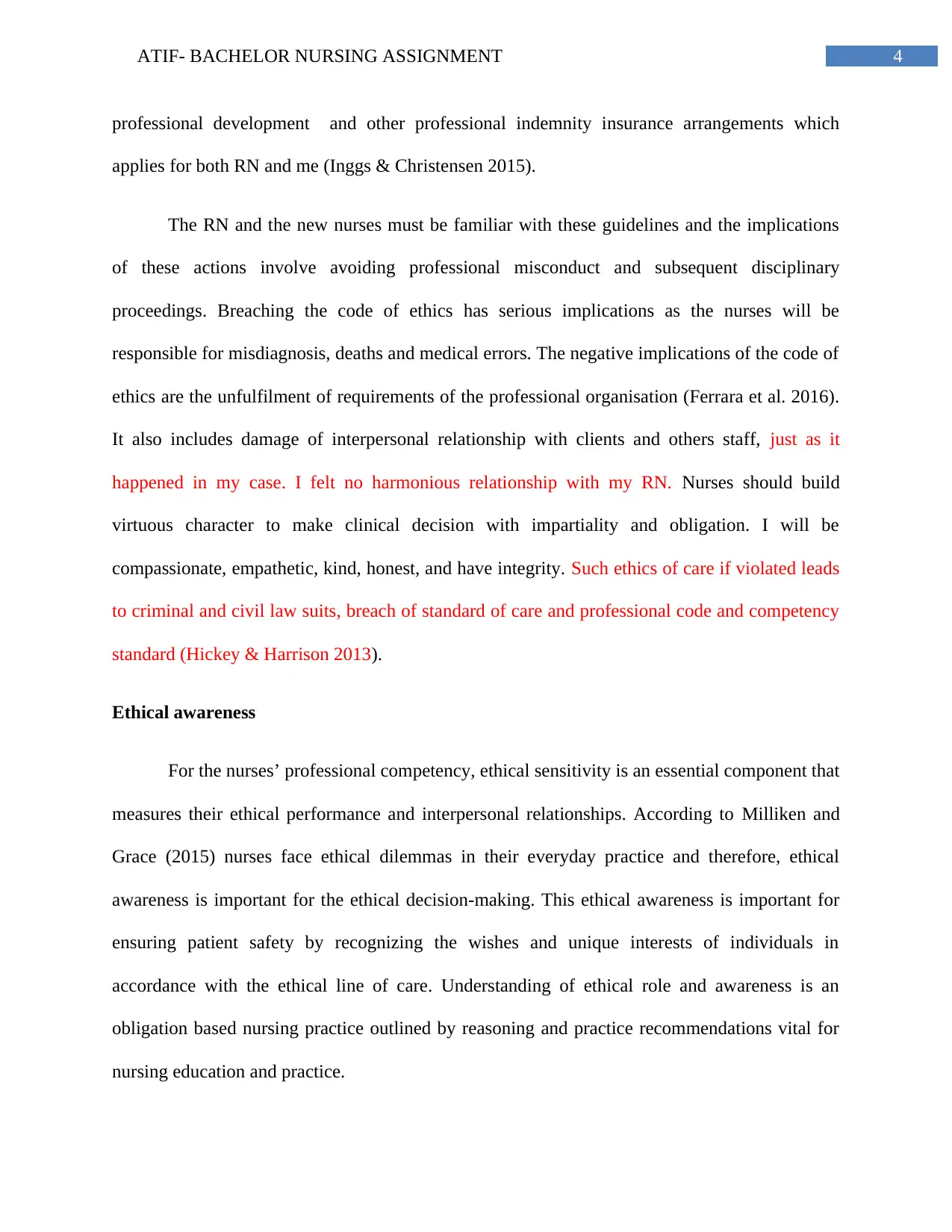
4ATIF- BACHELOR NURSING ASSIGNMENT
professional development and other professional indemnity insurance arrangements which
applies for both RN and me (Inggs & Christensen 2015).
The RN and the new nurses must be familiar with these guidelines and the implications
of these actions involve avoiding professional misconduct and subsequent disciplinary
proceedings. Breaching the code of ethics has serious implications as the nurses will be
responsible for misdiagnosis, deaths and medical errors. The negative implications of the code of
ethics are the unfulfilment of requirements of the professional organisation (Ferrara et al. 2016).
It also includes damage of interpersonal relationship with clients and others staff, just as it
happened in my case. I felt no harmonious relationship with my RN. Nurses should build
virtuous character to make clinical decision with impartiality and obligation. I will be
compassionate, empathetic, kind, honest, and have integrity. Such ethics of care if violated leads
to criminal and civil law suits, breach of standard of care and professional code and competency
standard (Hickey & Harrison 2013).
Ethical awareness
For the nurses’ professional competency, ethical sensitivity is an essential component that
measures their ethical performance and interpersonal relationships. According to Milliken and
Grace (2015) nurses face ethical dilemmas in their everyday practice and therefore, ethical
awareness is important for the ethical decision-making. This ethical awareness is important for
ensuring patient safety by recognizing the wishes and unique interests of individuals in
accordance with the ethical line of care. Understanding of ethical role and awareness is an
obligation based nursing practice outlined by reasoning and practice recommendations vital for
nursing education and practice.
professional development and other professional indemnity insurance arrangements which
applies for both RN and me (Inggs & Christensen 2015).
The RN and the new nurses must be familiar with these guidelines and the implications
of these actions involve avoiding professional misconduct and subsequent disciplinary
proceedings. Breaching the code of ethics has serious implications as the nurses will be
responsible for misdiagnosis, deaths and medical errors. The negative implications of the code of
ethics are the unfulfilment of requirements of the professional organisation (Ferrara et al. 2016).
It also includes damage of interpersonal relationship with clients and others staff, just as it
happened in my case. I felt no harmonious relationship with my RN. Nurses should build
virtuous character to make clinical decision with impartiality and obligation. I will be
compassionate, empathetic, kind, honest, and have integrity. Such ethics of care if violated leads
to criminal and civil law suits, breach of standard of care and professional code and competency
standard (Hickey & Harrison 2013).
Ethical awareness
For the nurses’ professional competency, ethical sensitivity is an essential component that
measures their ethical performance and interpersonal relationships. According to Milliken and
Grace (2015) nurses face ethical dilemmas in their everyday practice and therefore, ethical
awareness is important for the ethical decision-making. This ethical awareness is important for
ensuring patient safety by recognizing the wishes and unique interests of individuals in
accordance with the ethical line of care. Understanding of ethical role and awareness is an
obligation based nursing practice outlined by reasoning and practice recommendations vital for
nursing education and practice.
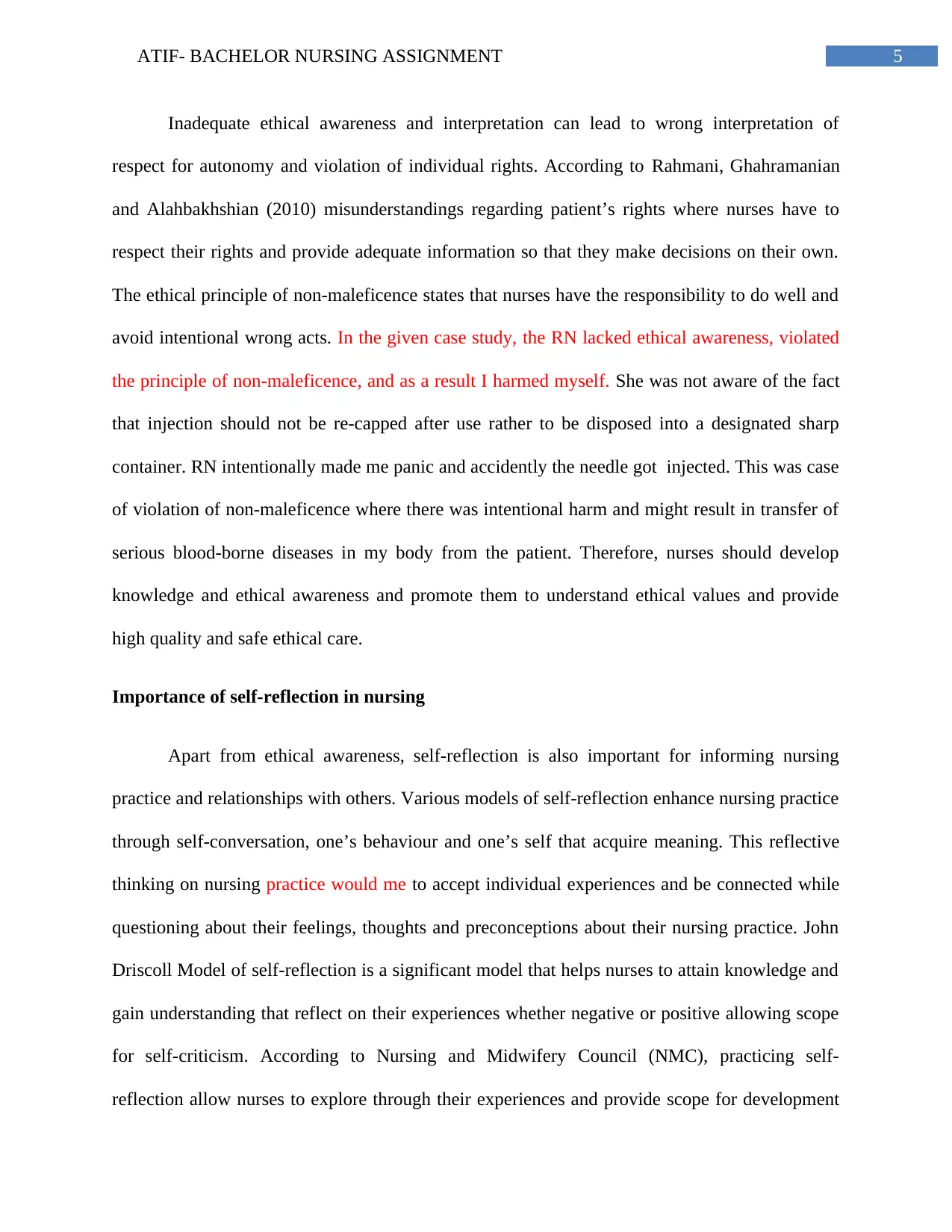
5ATIF- BACHELOR NURSING ASSIGNMENT
Inadequate ethical awareness and interpretation can lead to wrong interpretation of
respect for autonomy and violation of individual rights. According to Rahmani, Ghahramanian
and Alahbakhshian (2010) misunderstandings regarding patient’s rights where nurses have to
respect their rights and provide adequate information so that they make decisions on their own.
The ethical principle of non-maleficence states that nurses have the responsibility to do well and
avoid intentional wrong acts. In the given case study, the RN lacked ethical awareness, violated
the principle of non-maleficence, and as a result I harmed myself. She was not aware of the fact
that injection should not be re-capped after use rather to be disposed into a designated sharp
container. RN intentionally made me panic and accidently the needle got injected. This was case
of violation of non-maleficence where there was intentional harm and might result in transfer of
serious blood-borne diseases in my body from the patient. Therefore, nurses should develop
knowledge and ethical awareness and promote them to understand ethical values and provide
high quality and safe ethical care.
Importance of self-reflection in nursing
Apart from ethical awareness, self-reflection is also important for informing nursing
practice and relationships with others. Various models of self-reflection enhance nursing practice
through self-conversation, one’s behaviour and one’s self that acquire meaning. This reflective
thinking on nursing practice would me to accept individual experiences and be connected while
questioning about their feelings, thoughts and preconceptions about their nursing practice. John
Driscoll Model of self-reflection is a significant model that helps nurses to attain knowledge and
gain understanding that reflect on their experiences whether negative or positive allowing scope
for self-criticism. According to Nursing and Midwifery Council (NMC), practicing self-
reflection allow nurses to explore through their experiences and provide scope for development
Inadequate ethical awareness and interpretation can lead to wrong interpretation of
respect for autonomy and violation of individual rights. According to Rahmani, Ghahramanian
and Alahbakhshian (2010) misunderstandings regarding patient’s rights where nurses have to
respect their rights and provide adequate information so that they make decisions on their own.
The ethical principle of non-maleficence states that nurses have the responsibility to do well and
avoid intentional wrong acts. In the given case study, the RN lacked ethical awareness, violated
the principle of non-maleficence, and as a result I harmed myself. She was not aware of the fact
that injection should not be re-capped after use rather to be disposed into a designated sharp
container. RN intentionally made me panic and accidently the needle got injected. This was case
of violation of non-maleficence where there was intentional harm and might result in transfer of
serious blood-borne diseases in my body from the patient. Therefore, nurses should develop
knowledge and ethical awareness and promote them to understand ethical values and provide
high quality and safe ethical care.
Importance of self-reflection in nursing
Apart from ethical awareness, self-reflection is also important for informing nursing
practice and relationships with others. Various models of self-reflection enhance nursing practice
through self-conversation, one’s behaviour and one’s self that acquire meaning. This reflective
thinking on nursing practice would me to accept individual experiences and be connected while
questioning about their feelings, thoughts and preconceptions about their nursing practice. John
Driscoll Model of self-reflection is a significant model that helps nurses to attain knowledge and
gain understanding that reflect on their experiences whether negative or positive allowing scope
for self-criticism. According to Nursing and Midwifery Council (NMC), practicing self-
reflection allow nurses to explore through their experiences and provide scope for development
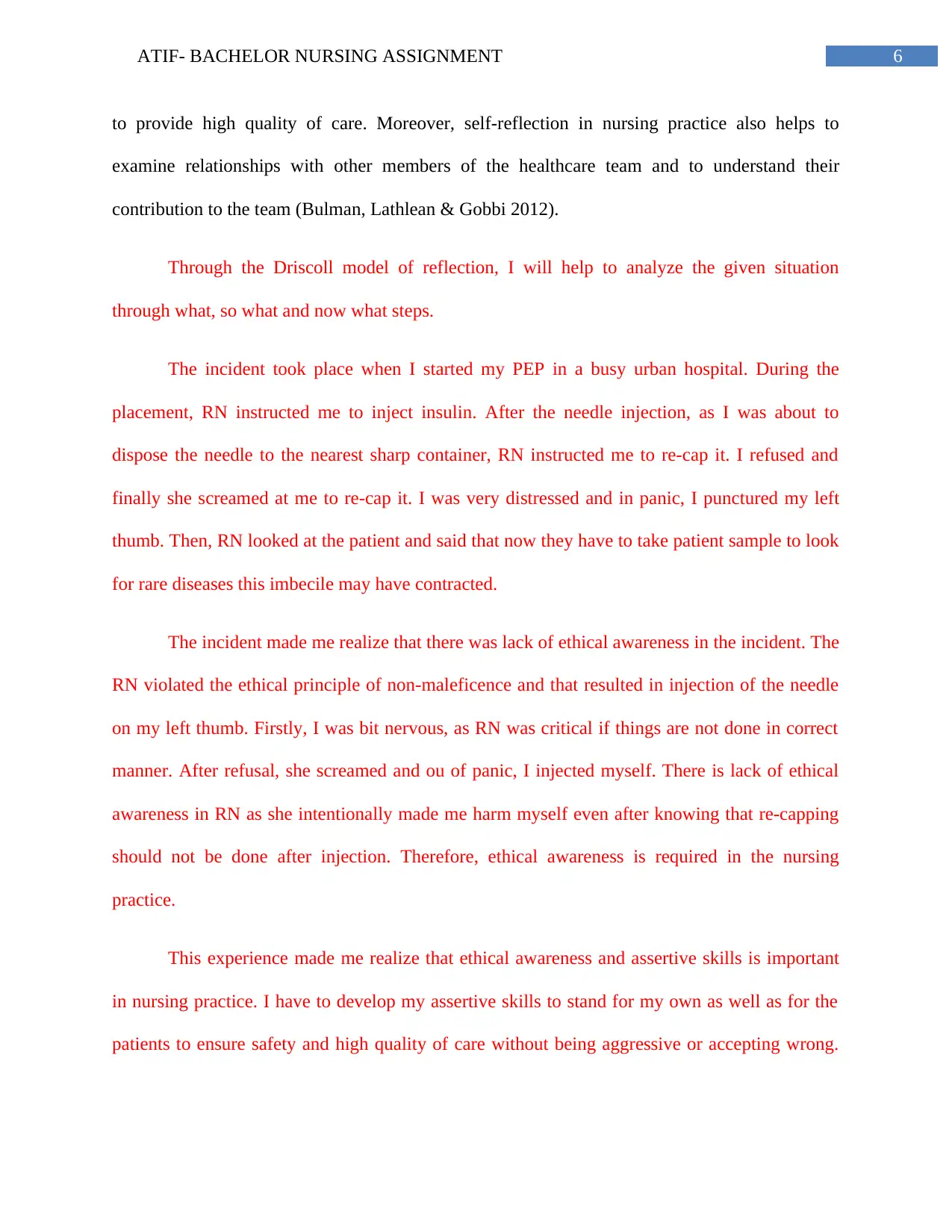
6ATIF- BACHELOR NURSING ASSIGNMENT
to provide high quality of care. Moreover, self-reflection in nursing practice also helps to
examine relationships with other members of the healthcare team and to understand their
contribution to the team (Bulman, Lathlean & Gobbi 2012).
Through the Driscoll model of reflection, I will help to analyze the given situation
through what, so what and now what steps.
The incident took place when I started my PEP in a busy urban hospital. During the
placement, RN instructed me to inject insulin. After the needle injection, as I was about to
dispose the needle to the nearest sharp container, RN instructed me to re-cap it. I refused and
finally she screamed at me to re-cap it. I was very distressed and in panic, I punctured my left
thumb. Then, RN looked at the patient and said that now they have to take patient sample to look
for rare diseases this imbecile may have contracted.
The incident made me realize that there was lack of ethical awareness in the incident. The
RN violated the ethical principle of non-maleficence and that resulted in injection of the needle
on my left thumb. Firstly, I was bit nervous, as RN was critical if things are not done in correct
manner. After refusal, she screamed and ou of panic, I injected myself. There is lack of ethical
awareness in RN as she intentionally made me harm myself even after knowing that re-capping
should not be done after injection. Therefore, ethical awareness is required in the nursing
practice.
This experience made me realize that ethical awareness and assertive skills is important
in nursing practice. I have to develop my assertive skills to stand for my own as well as for the
patients to ensure safety and high quality of care without being aggressive or accepting wrong.
to provide high quality of care. Moreover, self-reflection in nursing practice also helps to
examine relationships with other members of the healthcare team and to understand their
contribution to the team (Bulman, Lathlean & Gobbi 2012).
Through the Driscoll model of reflection, I will help to analyze the given situation
through what, so what and now what steps.
The incident took place when I started my PEP in a busy urban hospital. During the
placement, RN instructed me to inject insulin. After the needle injection, as I was about to
dispose the needle to the nearest sharp container, RN instructed me to re-cap it. I refused and
finally she screamed at me to re-cap it. I was very distressed and in panic, I punctured my left
thumb. Then, RN looked at the patient and said that now they have to take patient sample to look
for rare diseases this imbecile may have contracted.
The incident made me realize that there was lack of ethical awareness in the incident. The
RN violated the ethical principle of non-maleficence and that resulted in injection of the needle
on my left thumb. Firstly, I was bit nervous, as RN was critical if things are not done in correct
manner. After refusal, she screamed and ou of panic, I injected myself. There is lack of ethical
awareness in RN as she intentionally made me harm myself even after knowing that re-capping
should not be done after injection. Therefore, ethical awareness is required in the nursing
practice.
This experience made me realize that ethical awareness and assertive skills is important
in nursing practice. I have to develop my assertive skills to stand for my own as well as for the
patients to ensure safety and high quality of care without being aggressive or accepting wrong.
Paraphrase This Document
Need a fresh take? Get an instant paraphrase of this document with our AI Paraphraser
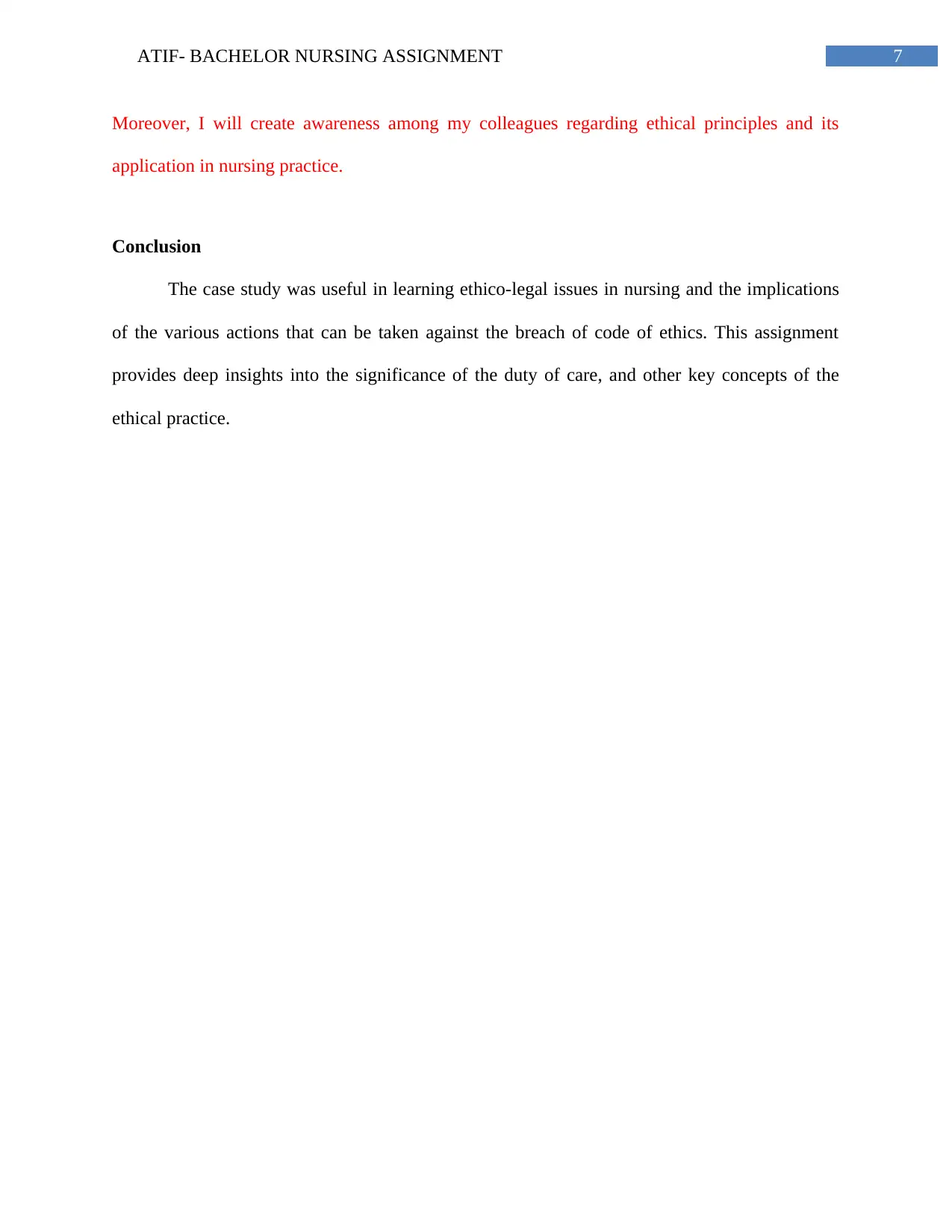
7ATIF- BACHELOR NURSING ASSIGNMENT
Moreover, I will create awareness among my colleagues regarding ethical principles and its
application in nursing practice.
Conclusion
The case study was useful in learning ethico-legal issues in nursing and the implications
of the various actions that can be taken against the breach of code of ethics. This assignment
provides deep insights into the significance of the duty of care, and other key concepts of the
ethical practice.
Moreover, I will create awareness among my colleagues regarding ethical principles and its
application in nursing practice.
Conclusion
The case study was useful in learning ethico-legal issues in nursing and the implications
of the various actions that can be taken against the breach of code of ethics. This assignment
provides deep insights into the significance of the duty of care, and other key concepts of the
ethical practice.
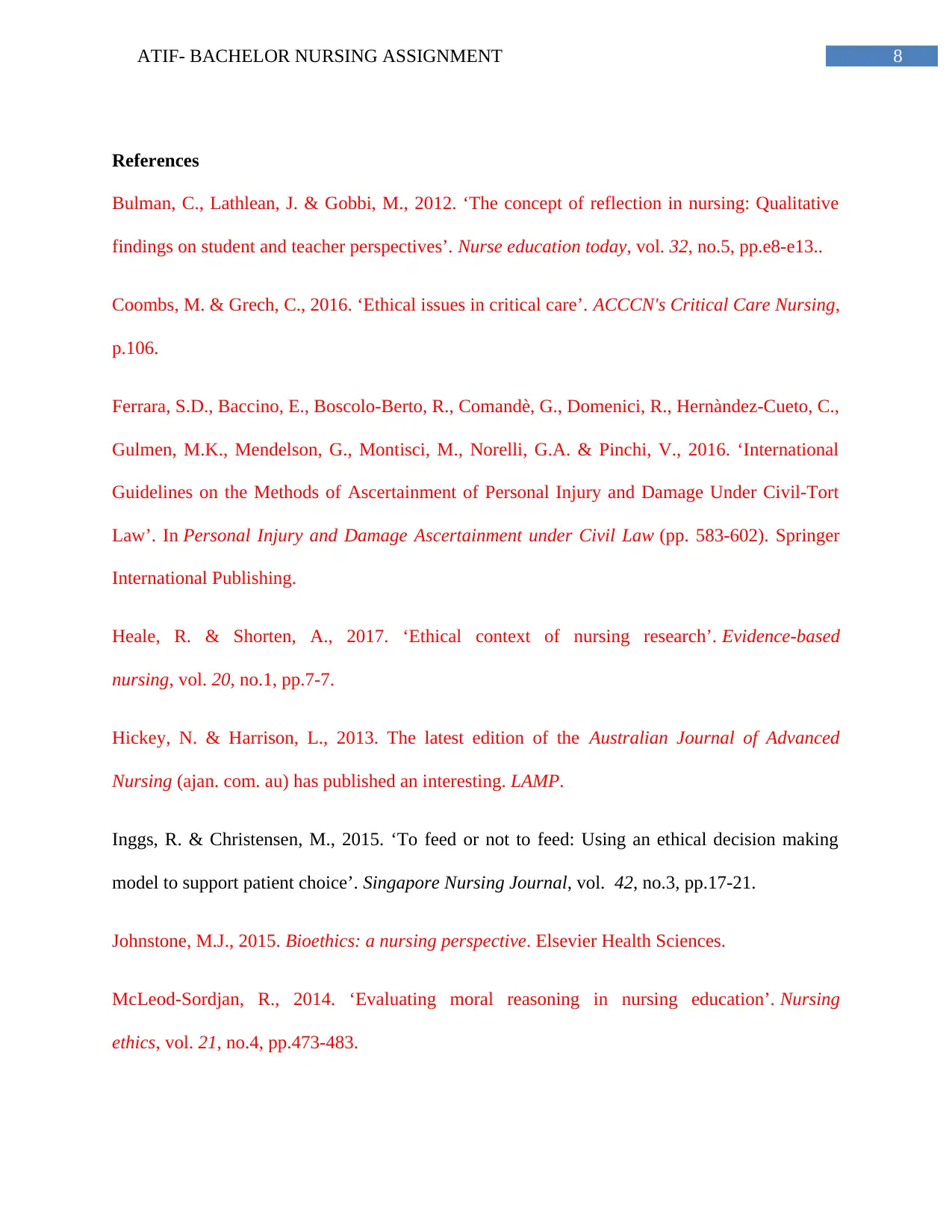
8ATIF- BACHELOR NURSING ASSIGNMENT
References
Bulman, C., Lathlean, J. & Gobbi, M., 2012. ‘The concept of reflection in nursing: Qualitative
findings on student and teacher perspectives’. Nurse education today, vol. 32, no.5, pp.e8-e13..
Coombs, M. & Grech, C., 2016. ‘Ethical issues in critical care’. ACCCN's Critical Care Nursing,
p.106.
Ferrara, S.D., Baccino, E., Boscolo-Berto, R., Comandè, G., Domenici, R., Hernàndez-Cueto, C.,
Gulmen, M.K., Mendelson, G., Montisci, M., Norelli, G.A. & Pinchi, V., 2016. ‘International
Guidelines on the Methods of Ascertainment of Personal Injury and Damage Under Civil-Tort
Law’. In Personal Injury and Damage Ascertainment under Civil Law (pp. 583-602). Springer
International Publishing.
Heale, R. & Shorten, A., 2017. ‘Ethical context of nursing research’. Evidence-based
nursing, vol. 20, no.1, pp.7-7.
Hickey, N. & Harrison, L., 2013. The latest edition of the Australian Journal of Advanced
Nursing (ajan. com. au) has published an interesting. LAMP.
Inggs, R. & Christensen, M., 2015. ‘To feed or not to feed: Using an ethical decision making
model to support patient choice’. Singapore Nursing Journal, vol. 42, no.3, pp.17-21.
Johnstone, M.J., 2015. Bioethics: a nursing perspective. Elsevier Health Sciences.
McLeod-Sordjan, R., 2014. ‘Evaluating moral reasoning in nursing education’. Nursing
ethics, vol. 21, no.4, pp.473-483.
References
Bulman, C., Lathlean, J. & Gobbi, M., 2012. ‘The concept of reflection in nursing: Qualitative
findings on student and teacher perspectives’. Nurse education today, vol. 32, no.5, pp.e8-e13..
Coombs, M. & Grech, C., 2016. ‘Ethical issues in critical care’. ACCCN's Critical Care Nursing,
p.106.
Ferrara, S.D., Baccino, E., Boscolo-Berto, R., Comandè, G., Domenici, R., Hernàndez-Cueto, C.,
Gulmen, M.K., Mendelson, G., Montisci, M., Norelli, G.A. & Pinchi, V., 2016. ‘International
Guidelines on the Methods of Ascertainment of Personal Injury and Damage Under Civil-Tort
Law’. In Personal Injury and Damage Ascertainment under Civil Law (pp. 583-602). Springer
International Publishing.
Heale, R. & Shorten, A., 2017. ‘Ethical context of nursing research’. Evidence-based
nursing, vol. 20, no.1, pp.7-7.
Hickey, N. & Harrison, L., 2013. The latest edition of the Australian Journal of Advanced
Nursing (ajan. com. au) has published an interesting. LAMP.
Inggs, R. & Christensen, M., 2015. ‘To feed or not to feed: Using an ethical decision making
model to support patient choice’. Singapore Nursing Journal, vol. 42, no.3, pp.17-21.
Johnstone, M.J., 2015. Bioethics: a nursing perspective. Elsevier Health Sciences.
McLeod-Sordjan, R., 2014. ‘Evaluating moral reasoning in nursing education’. Nursing
ethics, vol. 21, no.4, pp.473-483.
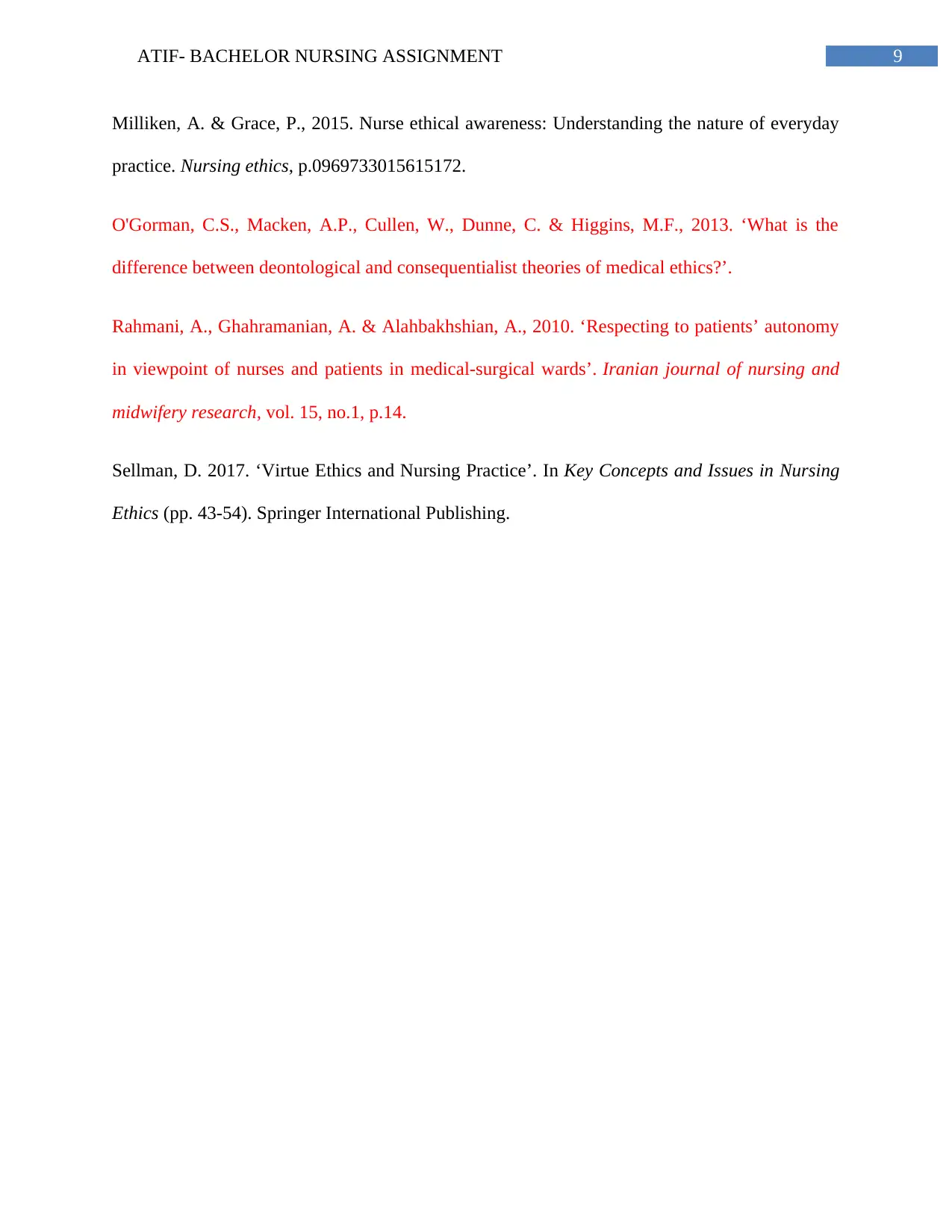
9ATIF- BACHELOR NURSING ASSIGNMENT
Milliken, A. & Grace, P., 2015. Nurse ethical awareness: Understanding the nature of everyday
practice. Nursing ethics, p.0969733015615172.
O'Gorman, C.S., Macken, A.P., Cullen, W., Dunne, C. & Higgins, M.F., 2013. ‘What is the
difference between deontological and consequentialist theories of medical ethics?’.
Rahmani, A., Ghahramanian, A. & Alahbakhshian, A., 2010. ‘Respecting to patients’ autonomy
in viewpoint of nurses and patients in medical-surgical wards’. Iranian journal of nursing and
midwifery research, vol. 15, no.1, p.14.
Sellman, D. 2017. ‘Virtue Ethics and Nursing Practice’. In Key Concepts and Issues in Nursing
Ethics (pp. 43-54). Springer International Publishing.
Milliken, A. & Grace, P., 2015. Nurse ethical awareness: Understanding the nature of everyday
practice. Nursing ethics, p.0969733015615172.
O'Gorman, C.S., Macken, A.P., Cullen, W., Dunne, C. & Higgins, M.F., 2013. ‘What is the
difference between deontological and consequentialist theories of medical ethics?’.
Rahmani, A., Ghahramanian, A. & Alahbakhshian, A., 2010. ‘Respecting to patients’ autonomy
in viewpoint of nurses and patients in medical-surgical wards’. Iranian journal of nursing and
midwifery research, vol. 15, no.1, p.14.
Sellman, D. 2017. ‘Virtue Ethics and Nursing Practice’. In Key Concepts and Issues in Nursing
Ethics (pp. 43-54). Springer International Publishing.
1 out of 10
Related Documents
Your All-in-One AI-Powered Toolkit for Academic Success.
+13062052269
info@desklib.com
Available 24*7 on WhatsApp / Email
![[object Object]](/_next/static/media/star-bottom.7253800d.svg)
Unlock your academic potential
© 2024 | Zucol Services PVT LTD | All rights reserved.




